Coronavirus (COVID-19) - disabled people: health, social and economic harms - research report
Looks at how the COVID-19 pandemic has impacted disabled people in Scotland by considering health, social and economic harms.
2. Demographic profile of COVID-19 deaths
Table 1, below, demonstrates that the demographic profile of COVID-19 deaths are similar in Scotland and England and Wales. People whose deaths involved COVID-19 were:
- more likely to be aged 75+;
- more likely to be a man;
- more likely to experience multiple deprivation;
- More likely to have a pre-existing medical condition.
Table 1: Demographic profile of COVID-19 deaths, Scotland, England and Wales
| Scotland | England and Wales | |
|---|---|---|
| Age | In week 25 to 31 January 2021 (week 4): 68% of deaths involving COVID-19 aged 75+.[28] | In week ending 29th January 2021 (week 4): 72.7% of deaths involving COVID-9 amongst people aged 75+.[29] |
| Sex | 51.2% of all deaths involving COVID-19 were amongst men.[30] | 54.5% of all deaths involving COVID-19 deaths were amongst men.[31] |
| Multiple deprivation | Most deprived 20% of areas 2.2 times higher COVID-19 mortality rate than the least deprived.[32] | Most deprived areas have between 2 and 3 times higher COVID-19 mortality rate than the least deprived areas.[33] |
| Pre-existing condition | 93% of deaths between March and December 2020 had at least one pre-existing condition.[34] | 91.1% of deaths between March and June 2020 had at least one pre-existing condition.[35] |
2.1 Frequency of types of health conditions in deaths involving COVID-19 in Scotland, England and Wales[36]
Disabled people have a range of limiting long-term physical health conditions, such as those affecting the heart and respiratory system, which are linked to increased vulnerability to COVID-19.[37] The figures discussed below demonstrate the main pre-existing medical conditions in deaths involving COVID-19, broken down by age and sex.
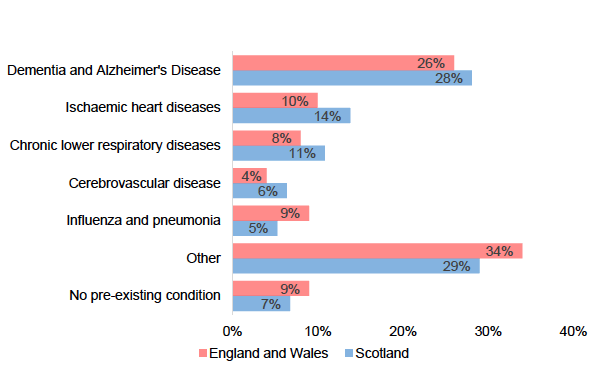
Sources: Deaths involving coronavirus (COVID-19) in Scotland, Week 2: Report (nrscotland.gov.uk); Deaths involving COVID-19, England and Wales - Office for National Statistics (ons.gov.uk) (June 2020)[38] [39]
'Deaths involving COVID in Scotland (monthly analysis)'[40] shows that, of the 6,834 deaths occurring between March and December 2020, 93% (6,372) of people who died had at least one pre-existing condition. This is very similar to England and Wales where, of the 50,335 deaths involving COVID-19, 91% (45,859) of people who died had at least one pre-existing health condition.
In Scotland, the most common pre-existing condition amongst those who died of COVID-19 between March and November 2020 was 'dementia and Alzheimer's disease', accounting for more than a quarter (28%) of all deaths involving COVID-19 (see figure 2 above). Similarly, in England and Wales, the most common pre-existing condition amongst those who died of COVID-19 was 'dementia and Alzheimer's disease', also accounting for more than a quarter (26%) of all deaths involving COVID-19 (see figure 2 above). It's worth noting here that 'dementia and Alzheimer's disease' is more common in the older population, so age may be a factor in these deaths as well as pre-existing condition.
It should be noted that the NRS death registration figures are produced using the same definition as those published by the ONS (for England and Wales) so are broadly comparable. However, the data for England and Wales dates from June 2020[41] whereas the Scottish data dates from December 2020. We are assuming that the same patterns continued in England and Wales. In addition, while ONS provide data on all pre-existing conditions involved in COVID-19 deaths, NRS provide details only for the main pre-existing conditions involved in COVID-19 deaths.
This data is for all people. To investigate this further we looked at the difference between older and younger men and older and younger women.
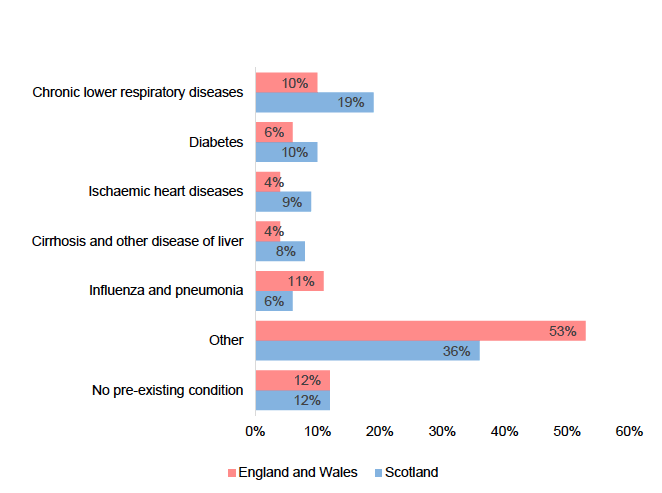
Sources: Deaths involving coronavirus (COVID-19) in Scotland, Week 2: Report (nrscotland.gov.uk); Deaths involving COVID-19, England and Wales - Office for National Statistics (ons.gov.uk) (June 2020)
Figure 3, above, shows the main pre-existing medical conditions in deaths involving COVID-19 among women aged under 65.[42] The main pre-existing conditions in deaths involving COVID-19 in Scotland among women aged under 65 were 'chronic lower respiratory diseases' (19%), and this proportion was almost double that of England and Wales (10%). The next most common pre-existing condition in Scotland was 'diabetes' (10%), and again this proportion was higher than England and Wales (6%). 'Ischaemic heart diseases' were the third most common pre-existing condition in deaths involving COVID-19 amongst women aged under 65 in Scotland (9%), and this was higher than England and Wales (4%). In Scotland 'cirrhosis and other disease of the liver' was present in 8% of deaths involving COVID-19 amongst women aged under 65, which was double the rate in England and Wales (4%).
'Influenza and pneumonia' were the main pre-existing conditions involved in deaths involving COVID-19 in England and Wales among women aged under 65 (in 11% of deaths), but this was only the fifth most common condition in COVID deaths in Scotland (in 6% of deaths). In addition, the proportion of 'other' conditions in deaths involving COVID-19 amongst women aged under 65 was substantially higher in England and Wales (53%) than Scotland (36%).
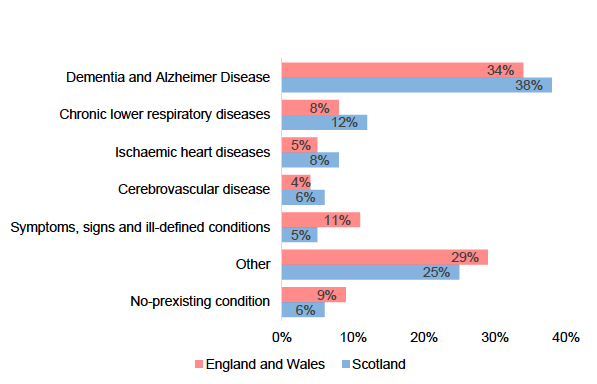
Sources: Deaths involving coronavirus (COVID-19) in Scotland, Week 2: Report (nrscotland.gov.uk); Deaths involving COVID-19, England and Wales - Office for National Statistics (ons.gov.uk) (June 2020)
There are noticeable similarities in the proportion of pre-existing medical conditions present in deaths involving COVID-19 for women aged 65+. Figure 4, above, shows that in England and Wales, the most common pre-existing medical condition in deaths involving COVID-19 for women aged 65+ was 'dementia and Alzheimer's disease' (34%), and this was also the case in Scotland (38%). The next most common conditions in England and Wales and also Scotland were 'chronic respiratory diseases', although the rate of these conditions were slightly higher in Scotland than England and Wales (8% and 12% respectively). There were similar rates of 'ischaemic heart diseases' (5% in England and Wales vs 8% in Scotland) and 'cerebrovascular disease' (4% in England and Wales and 6% in Scotland).
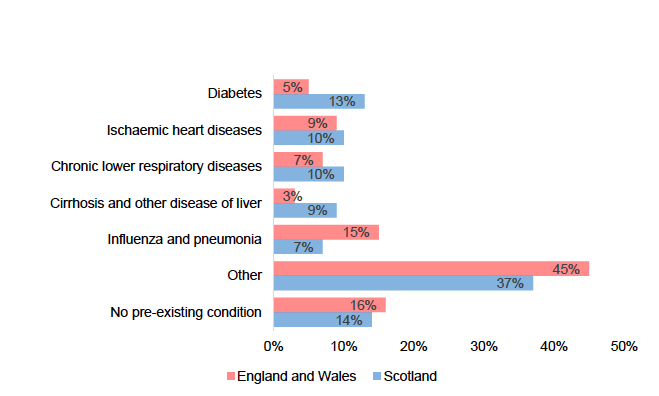
Sources: Deaths involving coronavirus (COVID-19) in Scotland, Week 2: Report (nrscotland.gov.uk); Deaths involving COVID-19, England and Wales - Office for National Statistics (ons.gov.uk) (June 2020)
Figure 5, above, demonstrates that for men in Scotland aged under 65[43] the main pre-existing medical condition in deaths involving COVID-19 was 'diabetes' (13%), but this was not the case in England and Wales where 'diabetes' was present in 5% of COVID-19 deaths. There were similar rates of 'ischaemic heart diseases' (10% in Scotland compared to 9% in England and Wales), and the rates of 'chronic lower respiratory diseases' were also fairly similar (10% in Scotland and 7% in England and Wales). However, the rate of 'cirrhosis and other disease of the liver' in Scotland was 3 times the rate in England and Wales (9% compared to 3%). The rate of 'influenza and pneumonia' in England and Wales was more than double the rate in Scotland (15% compared to 7%).
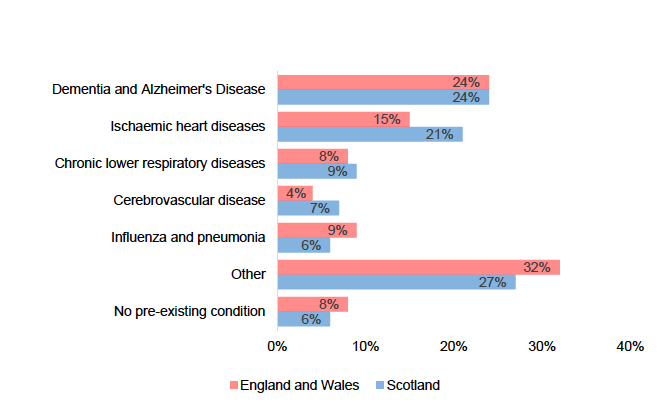
Sources: Deaths involving coronavirus (COVID-19) in Scotland, Week 2: Report (nrscotland.gov.uk); Deaths involving COVID-19, England and Wales - Office for National Statistics (ons.gov.uk) (June 2020)
Figure 6, above, demonstrates the main pre-existing conditions amongst men aged 65+ in deaths involving COVID-19 in England and Wales and Scotland, which are broadly similar. 'Dementia and Alzheimer's disease' were the most common pre-existing conditions in England and Wales (24%) and Scotland (24%). 'Ischaemic heart diseases' were the next most common, although the rate was higher in Scotland (21%) than England and Wales (15%). Rates of 'chronic lower respiratory diseases' were similar (8% in England and Wales and 9% in Scotland). In addition, rates of 'Influenza and pneumonia' were fairly similar in England and Wales (9%) and Scotland (6%), as was 'cerebrovascular disease' (7% in Scotland vs 4% in England and Wales), and 'other' conditions (32% in England and Wales and 27% in Scotland).
2.2. Weaknesses in the data
Based on the assessments above we would expect that the mortality rate of disabled people due to COVID-19 in Scotland would be very similar to England and Wales, particularly for the over 65s. However, this analysis has some weaknesses:
- The ONS study on COVID-19 mortality rates for disabled people is based on the 2011 Census population, which might not be representative of the current population. In particular, the data does not account for people who have developed a disability or health condition since 2011.
- Breakdown of deaths due to COVID-19 by underlying health conditions has not been reported since June 2020 in England and Wales due to small numbers of deaths posing a disclosure risk.
- We are also unable to judge whether different policy decisions, or differences in health and social care provision may also have an impact on these figures.
- In addition, this report does not account for the fact that the environment someone with a pre-existing condition lives in can impact mortality. For example, a person with dementia or Alzheimer's disease is more likely to live in a care home. Care homes residents have experienced higher COVID-19 mortality than non-care home residents.
NRS will be publishing an analysis of mortality rates for disabled people based on data linkage with the 2011 Census in March 2021.
Contact
There is a problem
Thanks for your feedback